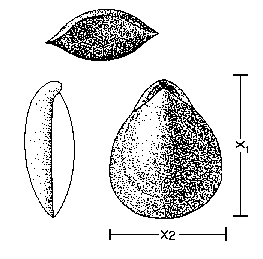
| Case study 1 - The Permian brachiopod Dielasma from the north of England |
Data file: dielasma.dat
The Permian brachiopod Dielasma is common at many localities within the Zechstein reef facies of the Ford Formation in the Sunderland area, N.E. England (Hollingworth & Pettigrew 1988). The smooth terebratulide brachiopod often forms monospecific clusters which are presumed to represent living assemblages at the base and within the reef. Large, well-preserved samples of the genus are available and a number of variates may be easily measured on complete specimens. Hollingworth & Pettigrew (1988) assessed the population structures and dynamics of a number of discrete populations of Dielasma in terms of salinity and other possible environmental fluctuations. Study of several samples suggest some populations were stunted; moreover it is possible that several subspecies or even species may be represented in the samples associated with the Permian reef.
| Two measurements were made, using vernier calipers, on three discrete samples of the terebratulide brachiopod Dielasma from the Ford Formation: the sagittal length (X1) and maximum width (X2) of the pedicle valve were taken on conjoined pairs. Data from three different sites (L1, L2 and L3) are available for analysis. With the information available it should be possible to compare and contrast the population structures and dynamics of each sample and moreover compare the relative outlines of the shells from all three localities. The data from all three localities are available on the file dielasma.dat. |

|
Also plot survivorship curves. How do these work?
The graphs for all three data files have different shapes. Why apparently are no minute growth stages represented in any of the samples? Account for the bimodal peaks manifest in the L1 data set. In marked contrast, L2 has a strong unimodal peak, with apparent high infant mortality, whereas L3 is trimodal. Explain!
More information about the plotting functions can be found in the manual.
Also compare the X1 values from the different localities using the F and t tests, the Kolmogorov-Smirnov test or the Mann-Whitney U test as appropriate.
More information about linear regression can be found in the manual.
Professor William King first monographed these brachiopods on 1850 and established several subspecies of Dielasma. Do your analyses support King's observations?